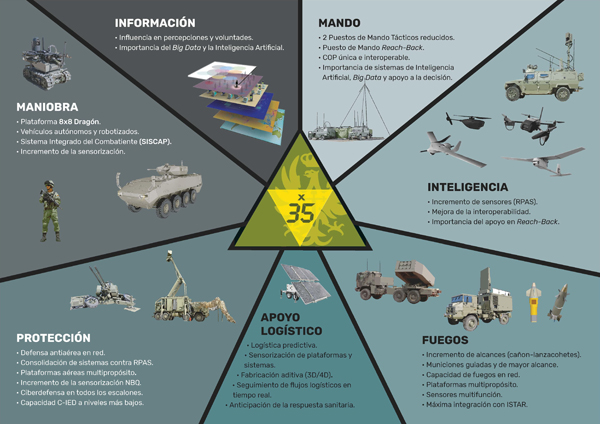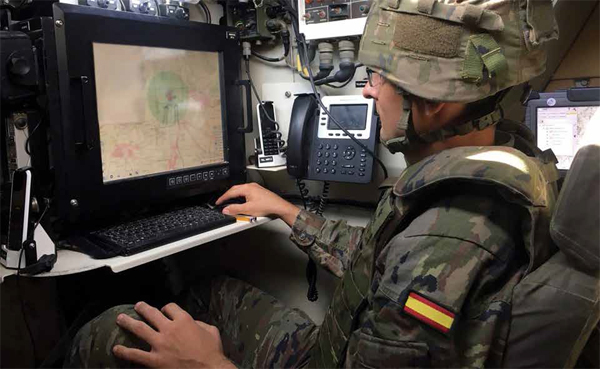- Inici
- Texto no traducido
- Towards a 4.0 Army
Towards a 4.0 Army
martes 12 de mayo de 2020
Nombre: 98
The second phase of the Digital Transformation Plan from the Ministry of Defence will allow for Army staff to be restructured towards more operative tasks.
Data is crucial when it comes time to make a decision. So much so that it has been said that data is the petrol of the 21st century. Businesses and organisations are constantly relying on it and, with the help of new technologies, they achieve agility and efficiency to transform them into extremely useful information.
With this in mind, Public Administration has opted for digitalisation and, specifically, the Ministry of Defence has its own Digital Transformation Action Plan that affects the Army, of course.
With the first phase practically finished, it is now time to implement the second phase, with which the Army will face an important challenge: “We will have to document, relate and declare all of the Army’s processes, their input data and the resulting information products,” underlines Colonel Morón, head of the newly created Section of Processes and Information Management and Knowledge, which is part of the General Secretariat of the Chief of Saff of the Army.
All of this should be in accordance with the Information Strategy from the Ministry of Defence, the Training for the Coordination for the Management of Information and Knowledge, which it is developing, and the Digital Transformation Plan, which is already underway.
Whilst the first phase of the Plan, which began in 2018, was more focussed on relations between the Ministry of Defence and the rest of the Administration, and included actions such as the implantation of the online site, this phase is more inward looking, and involves the facilities and services which affect defence, crisis situations and the security of the information.
“This second phase of the Plan, which will soon be published, involves a series of actions with deadlines, within which they have to be executed, and affects 52 vital information systems in the current operation of the Army,” explains the colonel. Thus, he points out: “Above all, it is a change in mentality requiring the elimination of prejudices.”

PILLARS:
1. Data oriented
It is essential to understand that the foundation of the whole organisation is the quality of its data. This is why the aim is for each element of information to be a unique source of truth, that is, based on unique and accessible data, avoiding duplication, lack of coordination and delays in decision-making. In this way, members of the organisation who require it will be able to have the information products necessary to fulfill the mission in a standardised, agile and reliable way.
2. Process
They must document and relate in a hierarchical way the operative and functional processes to configure the Army’s processes map.
3. Service oriented
This is established on the basis of the two previous pillars. It consists of making the most of the advantages of the new technologies such as big data, robotisation, machine learning or artificial intelligence, amongst others. For this, they will establish a Harmonisation Platform for the Management of the Organisation (ARGO, to use its Spanish acronym), upon which the applications which carry out the previous processes will be put into place.
How will this affect staff?
The transformation process will affect staff and will largely free them up from bureaucratic tasks, which can be automated. In this way, it will provide greater coverage to the most operational positions.
The new culture of organisation will allow for greater use of human capabilities. All those who carry out tasks which can be automated will be able to dedicate themselves to sharing their knowledge and creativity, in line with the objectives of the command. In this way, the availability of precise and up to date information for every level will allow the practical application of Mission Command. In this philosophy, Digital Transformation will allow for each combatant, empowered by the technology’s possibilities, and within an organisation which is focussed on the mission, to contribute their will, values, preparation and experience to fulfil the mission.
A turning point
The Army’s obligation to take on the second phase of the Digital Transformation Plan is also an opportunity to organise its information and optimise their processes, in line with the project of Force 35 and the Mission-Oriented Organisation, making the most of the technological revolution which has already started and thus face, with greater guarantees of success, the complex future operational environment.
Having created the Digital Transformation Work Group in the summer of 2019, and currently setting up the Section of Processes and Information Management and Kowledge, the Army is aware of the change this represents and is not taken by surprise.
To adopt the changes which this implies requires the commitment of everyone, as actors and driving forces. “Each individual has the greatest specific knowledge in their post, provided by practice and daily experience. For this reason each person is best placed to contribute to documenting and improving the processes of which they are a part,” explains the colonel.
With all of this, the Army’s Command and Direction System will be updated towards a 4.0 concept, which will strengthen the organic chain and simplify functional relations.

UNITATS DE L'EXÈRCIT
- Araba Álava |
- Albacete |
- Alicante |
- Almería |
- Asturias |
- Ávila |
- Badajoz |
- Barcelona |
- Burgos |
- Cáceres |
- Cádiz |
- Cantabria |
- Castellón |
- Ceuta |
- Ciudad Real |
- Córdoba |
- A Coruña |
- Cuenca |
- Girona |
- Granada |
- Guadalajara |
- Gipuzkoa |
- Huelva |
- Huesca |
- Islas Baleares |
- Jaén |
- León |
- Lleida |
- Lugo |
- Madrid |
- Málaga |
- Melilla |
- Murcia |
- Navarra |
- Ourense |
- Palencia |
- Las Palmas |
- Pontevedra |
- La Rioja |
- Salamanca |
- Segovia |
- Sevilla |
- Soria |
- Tarragona |
- Santa Cruz de Tenerife |
- Teruel |
- Toledo |
- Valencia |
- Valladolid |
- Bizkaia |
- Zamora |
- Zaragoza



